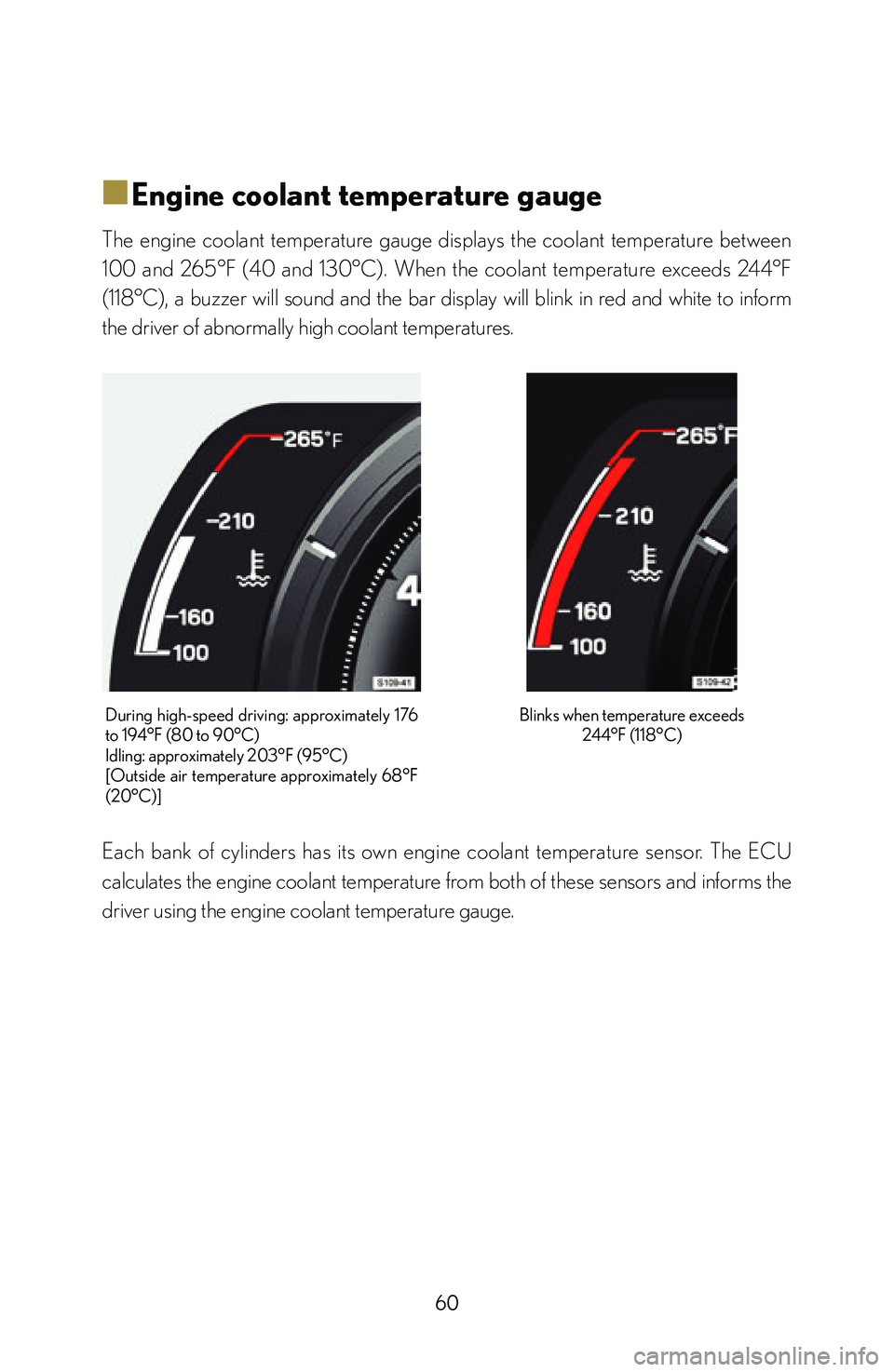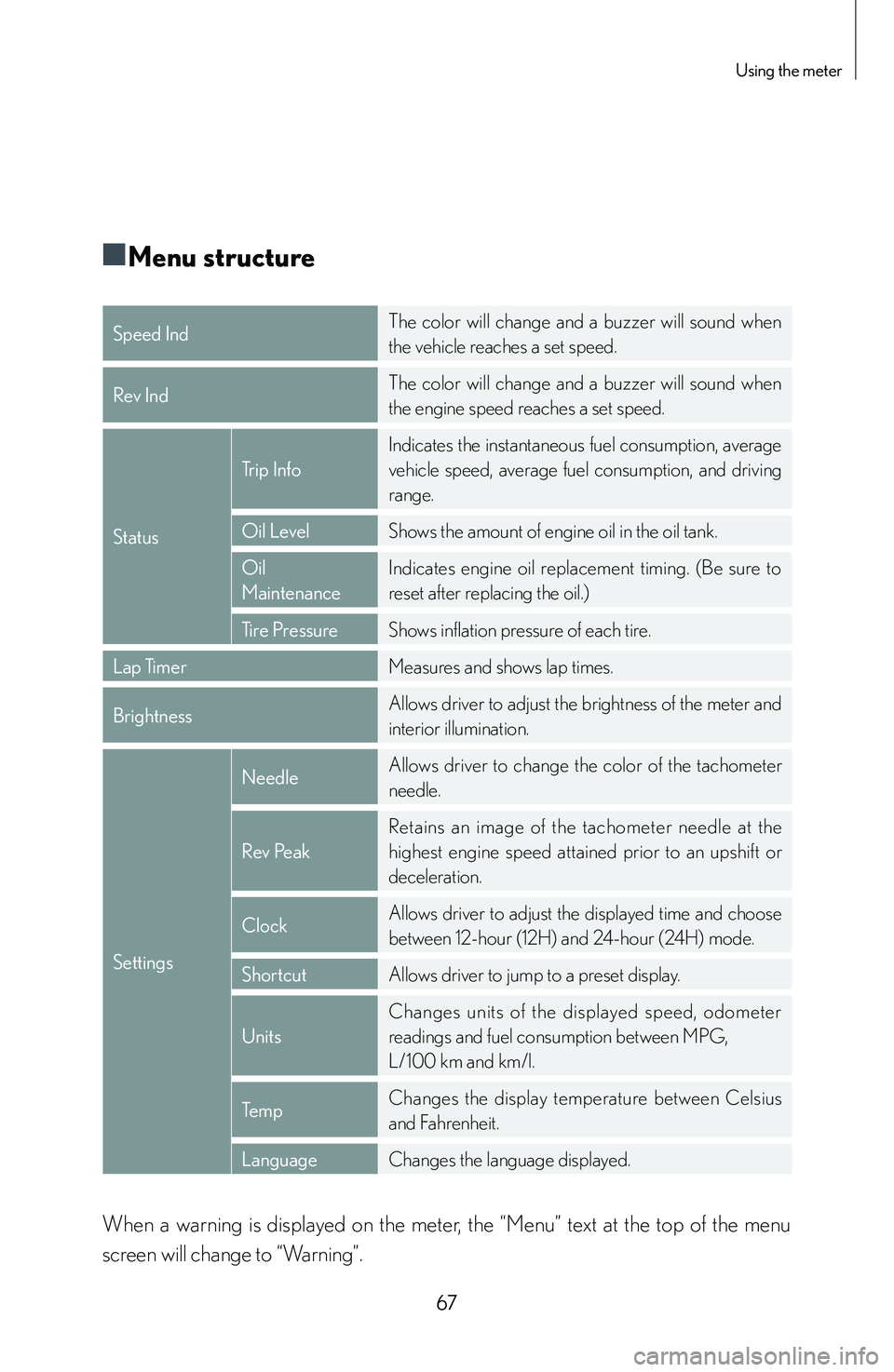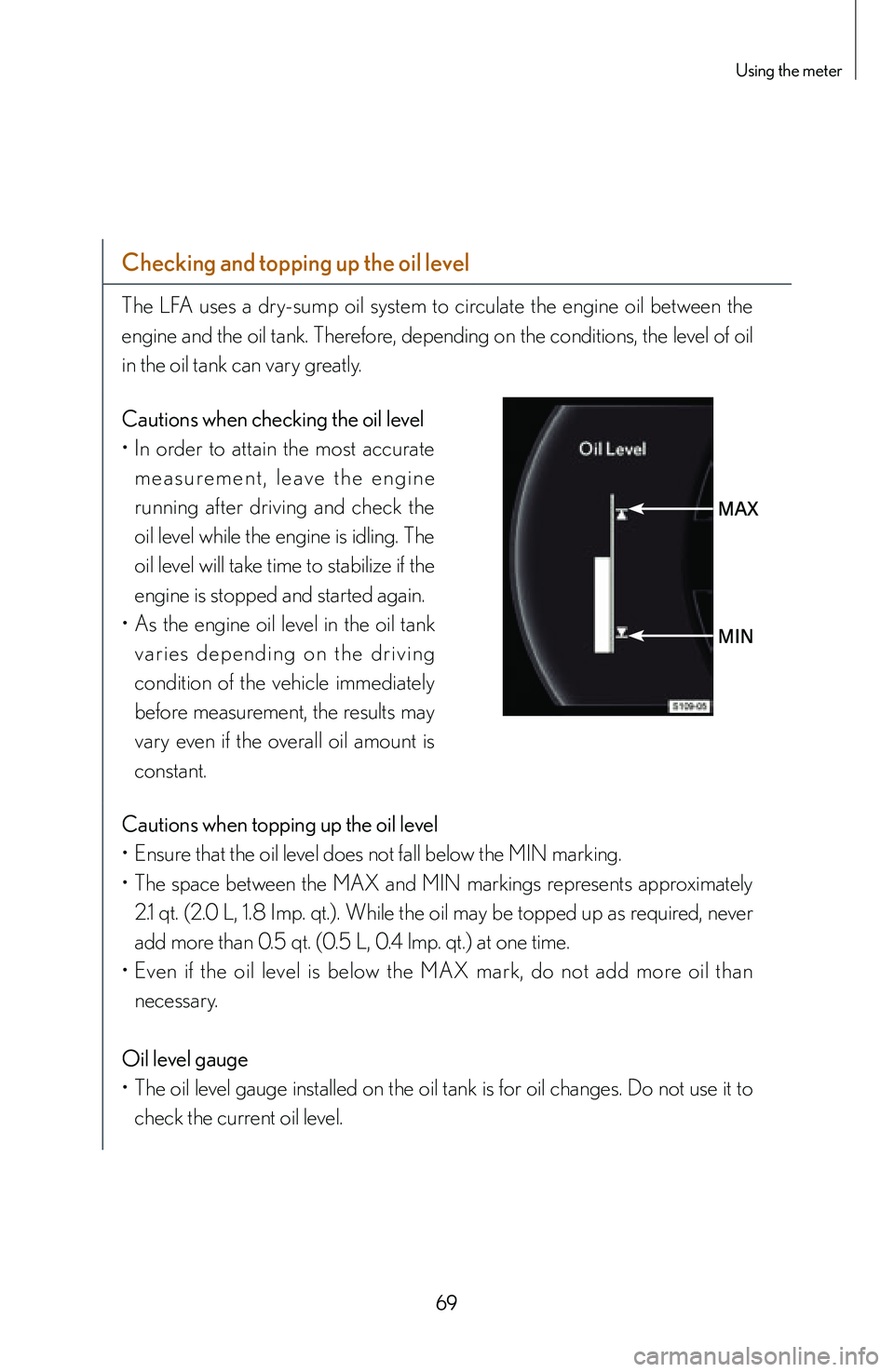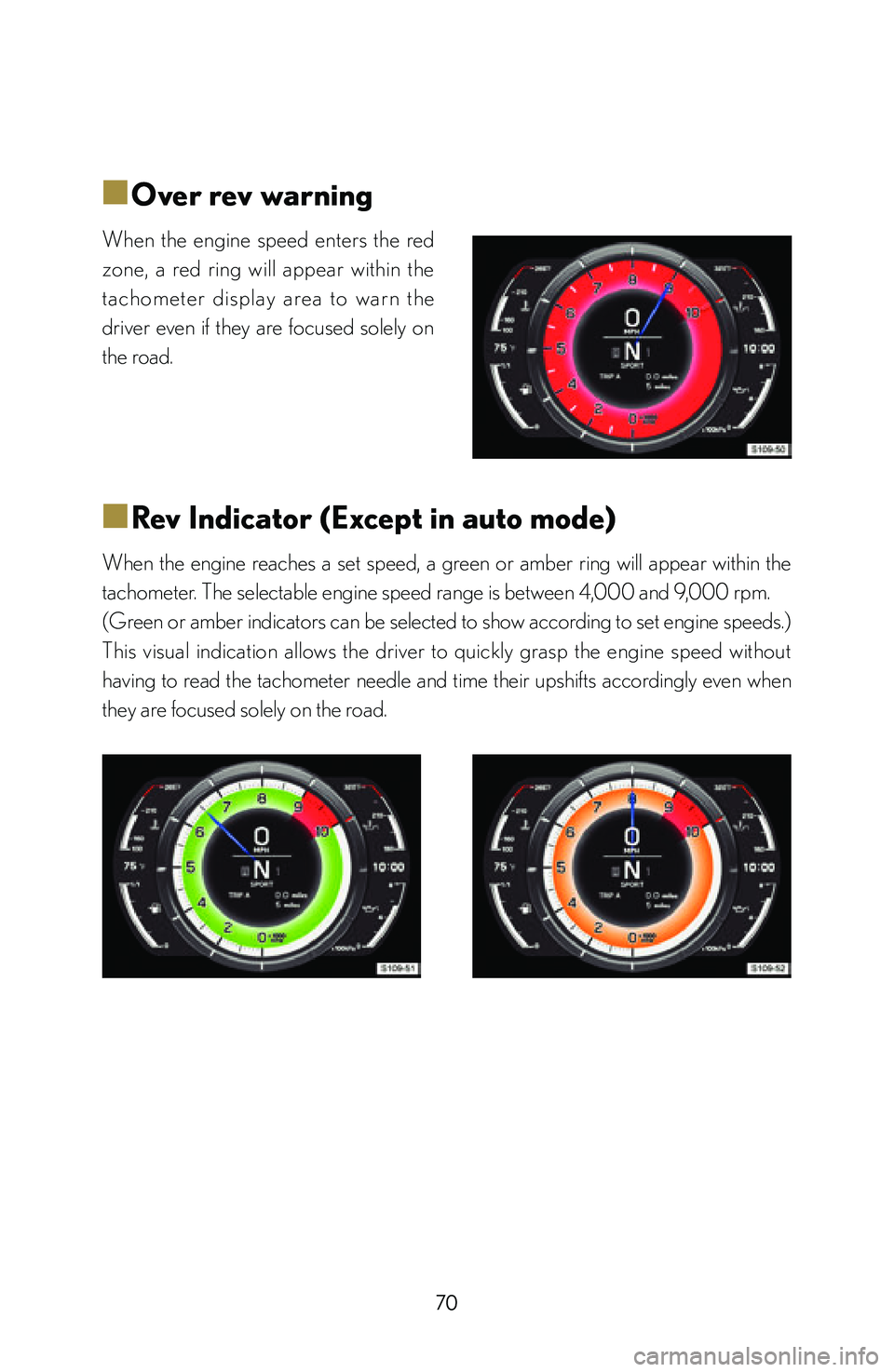engine lexus LFA 2012 Technical Information / LEXUS 2012 LFA: INSIDE THE LFA
[x] Cancel search | Manufacturer: LEXUS, Model Year: 2012, Model line: LFA, Model: Lexus LFA 2012Pages: 128, PDF Size: 5.91 MB
Page 62 of 128

60
■
■Engine coolant temperature gauge
The engine coolant temperature gauge displays the coolant temperature between
100 and 265°F (40 and 130°C). When the coolant temperature exceeds 244°F
(118°C), a buzzer will sound and the bar display will blink in red and white to inform
the driver of abnormally high coolant temperatures.
During high-speed driving: approximately 176
to 194°F (80 to 90°C)
Idling: approximately 203°F (95°C)
[Outside air temperature approximately 68°F
(20°C)]Blinks when temperature exceeds
244°F (118°C)
Each bank of cylinders has its own engine coolant temperature sensor. The ECU
calculates the engine coolant temperature from both of these sensors and informs the
driver using the engine coolant temperature gauge.
Page 63 of 128

61
Checking the engine
■
■Engine oil temperature gauge
The engine oil temperature gauge displays the oil temperature from 100 to 320°F
(40 to 160°C). When the oil temperature exceeds 284°F (140°C), a buzzer will
sound and the bar display will blink in red and white to inform the driver that the
oil temperature is abnormally high and that the performance and lifespan of the
oil is severely compromised. Allowing the engine oil to cool and maintain a stable
temperature helps to stabilize its performance.
During high-speed driving: approximately 176
to 194°F (80 to 90°C)
[Outside air temperature approximately 68°F
(20°C)]Blinks when temperature exceeds
284°F (140°C)
An oil temperature sensor is installed near the oil filter to monitor the temperature
of the engine oil supplied by the oil pump. The ECU processes the engine oil
temperature from this sensor and informs the driver using the engine oil temperature
gauge.
Page 64 of 128

62
■
■Engine oil pressure gauge
The engine oil pressure gauge displays the engine oil pressure from 0 to 800
kPa. The rapid response of the TFT LCD panel allows for the fluctuations in engine
oil pressure that occur with engine speed to be displayed instantly. The engine oil
pressure is also affected by other factors such as engine oil type, temperature and
deterioration. If the engine oil pressure is too low, the master warning light comes on
and the “Engine oil pressure low” warning message is displayed. Checking the engine
oil pressure regularly aids understanding of the condition of the engine and engine oil.
During high-speed driving: approximately 400
to 800 kPa
(changes depending on driving conditions)
[Outside air temperature approximately 68°F
(20°C)]
When oil pressure is insufficient
An oil pressure sensor is installed near the oil filter.
The oil pressure measurements are processed by the ECU and displayed by the
engine oil pressure gauge.
Page 65 of 128

63
Checking the engine
■
■Fuel gauge
The fuel gauge displays the amount of fuel remaining on a scale of 0 to 1/1. The
saddle-shaped fuel tank consists of a main tank compartment and a sub-tank
compartment. When the fuel level drops to approximately 2.9 gal. (11 L, 2.4 Imp. gal.)
between both compartments, the bar display will blink in amber to inform the driver
that the remaining fuel level is low. In this state, the remaining amount of fuel is directed
into the main tank compartment in order to ensure a stable supply of fuel to the engine
even under high cornering G-loads.
S109-14Main tank
compartment Sub-tank compartment
Fuel
Remaining fuel directed to main tank
compartment
Blinks when remaining fuel drops to approx. 2.9 gal. (11 L, 2.4 Imp. gal.)
The main tank compar tment and sub-tank compar tment each have their own
individual sender gauges to monitor the fuel levels. The ECU calculates the total
amount of fuel remaining from both of these sensors and informs the driver using
the fuel gauge. The ECU digitally processes the fuel level data in order to display a
clear and accurate fuel level even when the fuel level fluctuates under high cornering
G-loads.
Page 69 of 128

67
Using the meter
■
■Menu structure
Speed Ind The color will change and a buzzer will sound when
the vehicle reaches a set speed.
Rev Ind The color will change and a buzzer will sound when
the engine speed reaches a set speed.
Status Trip Info
Indicates the instantaneous fuel consumption, average
vehicle speed, average fuel consumption, and driving
range.
Oil Level Shows the amount of engine oil in the oil tank.
Oil
Maintenance Indicates engine oil replacement timing. (Be sure to
reset after replacing the oil.)
Tire Pressure Shows inflation pressure of each tire.
Lap Timer Measures and shows lap times.
Brightness Allows driver to adjust the brightness of the meter and
interior illumination.
Settings Needle
Allows driver to change the color of the tachometer
needle.
Rev Peak Retains an image of the tachometer needle at the
highest engine speed attained prior to an upshift or
deceleration.
Clock Allows driver to adjust the displayed time and choose
between 12-hour (12H) and 24-hour (24H) mode.
Shortcut Allows driver to jump to a preset display.
Units Changes units of the displayed speed, odometer
readings and fuel consumption between MPG,
L/100 km and km/l.
Temp Changes the display temperature between Celsius
and Fahrenheit.
Language Changes the language displayed.
When a warning is displayed on the meter, the “Menu” text at the top of the menu
screen will change to “Warning”.
Page 70 of 128

68
■
■Oil level
An oil level sensor is installed in the oil tank to measure the amount of oil present. The
reading from this sensor is displayed to the driver. This allows the engine oil level to
be checked simply by operating the control pad, without needing to get out of the
vehicle.
■
■Measurement
1 Select “Status”2 Select “Oil Level”
3 Displays
measur
ement result
Measurement is possible when the following
conditions are met:
1. Engine oil temperature: Between 203 and
230 °F (95 and 110°C)
2. Engine speed: Between 900 and 1, 100 rpm
3. Vehicle status: Stationary and idling
4. Vehicle level: Allowable inclination of 4 degrees
or less.
Example of display when
conditions are not met
Page 71 of 128

69
Using the meter
Checking and topping up the oil level
The LFA uses a dry-sump oil system to circulate the engine oil between the
engine and the oil tank. Therefore, depending on the conditions, the level of oil
in the oil tank can vary greatly.
Cautions when checking the oil level
• In order to attain the most accurate
m e a s u r e m e n t , l e a v e t h e e n g i n e
running after driving and check the
oil level while the engine is idling. The
oil level will take time to stabilize if the
engine is stopped and started again.
• As the engine oil level in the oil tank
va r i e s d e p e n d i n g o n t h e d r i v i n g
condition of the vehicle immediately
before measurement, the results may
vary even if the overall oil amount is
constant.
MAX
MIN
Cautions when topping up the oil level
• Ensure that the oil level does not fall below the MIN marking.
• The space between the MAX and MIN markings represents approximately
2.1 qt. (2.0 L, 1.8 Imp. qt.). While the oil may be topped up as required, never
add more than 0.5 qt. (0.5 L, 0.4 lmp. qt.) at one time.
• Even if the oil level is below the MAX mark, do not add more oil than
necessary.
Oil level gauge
• The oil level gauge installed on the oil tank is for oil changes. Do not use it to
check the current oil level.
Page 72 of 128

70
■
■Over rev warning
When the engine speed enters the red
zone, a red ring will appear within the
tachometer display area to warn the
driver even if they are focused solely on
the road.
■
■Rev Indicator (Except in auto mode)
When the engine reaches a set speed, a green or amber ring will appear within the
tachometer. The selectable engine speed range is between 4,000 and 9,000 rpm.
(Green or amber indicators can be selected to show according to set engine speeds.)
This visual indication allows the driver to quickly grasp the engine speed without
having to read the tachometer needle and time their upshifts accordingly even when
they are focused solely on the road.
Page 73 of 128

71
Using the meter
■
■Rev Peak
An afterimage of the tachometer needle at the highest engine speed attained prior
to an upshift or deceleration will be retained for approximately 0.5 seconds. This
function simulates the “telltale needle” used in traditional analog racing tachometers to
help the driver time their upshifts and check over-revs on downshifting etc.
The Rev Peak function can be turned on or off from “Settings” on the menu display.
The color of the tachometer needle afterimage will change in accordance with that of
the actual tachometer needle.
Tachometer needle colorTachometer afterimage needle color
Blue Red
Red Blue
White Blue
Page 81 of 128

79
Maintaining the vehicle’s exterior
When washing the vehicle, be careful not to
touch the hood grilles, bezels in the radiator
grilles, or exhaust pipes and surrounding
area until they have cooled sufficiently, as
these components may cause burns.
• Do not apply water to the inside of the engine compartment. Doing so may cause the
electrical components etc. to catch fire.
• Do not flush water over or into the hood grilles (especially the arrowed portion in the
illustration).
• Do not flush water over or into the exhaust pipes and surrounding area or the bezels in
the radiator grilles until they have cooled sufficiently.
When using a high-pressure washer
• Do not aim the head of the nozzle at the hood grilles or radiator grilles. Doing so may
negatively affect the engine or cause a malfunction in the electric cooling fan motors that
may result in overheating.
• Do not allow the nozzles of the car wash to come within close proximity of the windows
or rear hatch.
Do not use automatic car washes as they may scratch the vehicle body and damage
the paint.